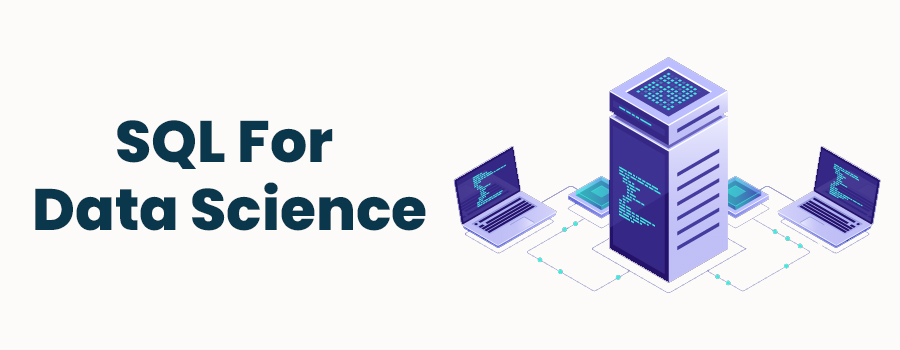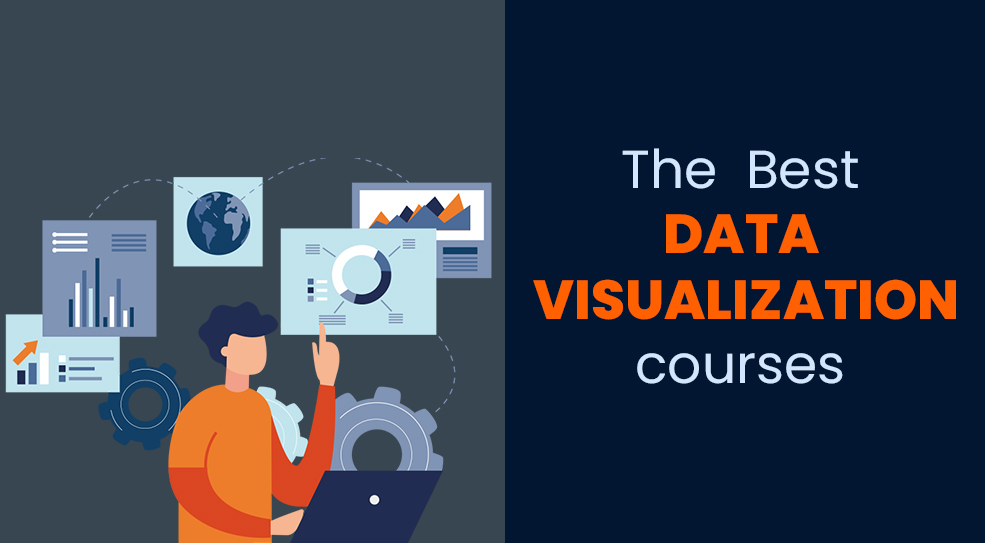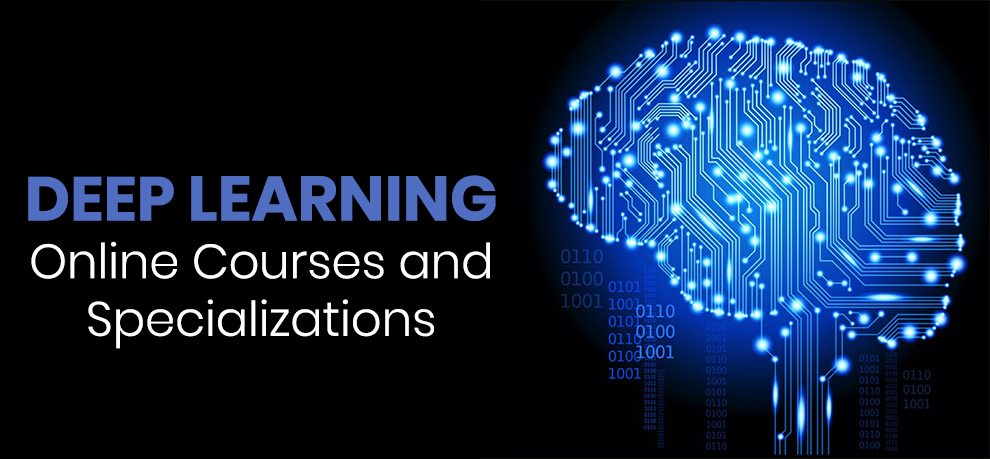Data Science is a rapidly growing area with tremendous growth potential. We’ve probably all heard of the best Data Science talents. To begin, SQL is the simplest and most important skill that every data science aspirant should learn.
Nowadays, most businesses are becoming data-driven. The needed data is kept in a database, which is managed and processed by a database management system. DBMS makes our work much easier and more organized.
As a result, it is critical to merge the most popular programming language with the fantastic DBMS solution.
SQL is the most used programming language when interacting with databases, and it is supported by many relational database systems, including MySQL, SQL Server, and Oracle.
However, some elements of the SQL standard are implemented differently in different database systems. As a result, SQL in data science has become one of the most crucial concepts to master in the discipline of Data Science.
In This Article
6 Best Courses To Learn SQL For Data Science
1. SQL for Data Science by UC Davis – (Coursera)
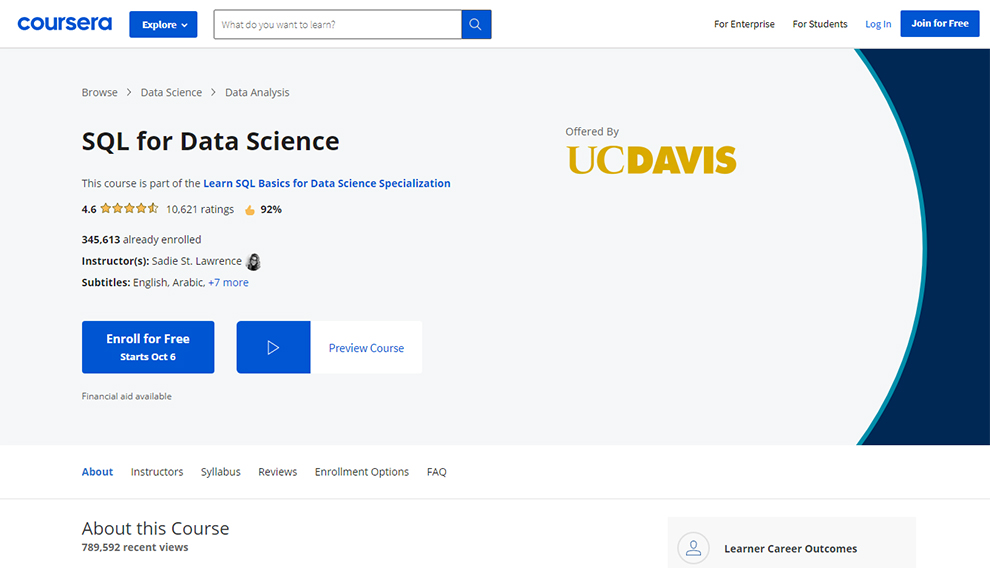
As the volume of collected data continues to surge, there is a rising demand for individuals proficient in handling and analyzing data. These professionals play a crucial role in critically thinking about data and offering insights to facilitate better decision-making and operational optimization for businesses.
According to Glassdoor, a data scientist is considered a top job in America, boasting a typical base income of $110,000 and a plethora of job opportunities available at any given time.
To become a proficient data scientist, one must possess the ability to retrieve and manipulate data. Mastery of SQL, the standard language for interfacing with database systems, is essential.
This SQL for data science certification course equips you with the fundamental knowledge required for SQL and data handling. Designed to be accessible even for beginners, the course begins with essential concepts. As you progress, you will learn to construct queries to extract specific data and apply filtering techniques. The curriculum covers creating new tables, and data migration, and introduces concepts related to strings and numbers.
The course delves into common operations and teaches you how to merge data effectively. Advanced topics include the application of case statements and adherence to principles like data governance and profiling. Real-world programming assignments provide practical experience, reinforcing your understanding of data concepts.
You will evaluate the structure, meaning, and relationships in source data and shape your data for targeted analysis using SQL as a professional.
| Rating | 4.6 based on 10500+ ratings |
| Duration | 14 hours |
| Level | Beginners |
| Refund Policy | For pre-paid courses, you can ask for a refund for up to 2 weeks |
| Certificate Provided | Yes |
| Course Material Provided | Yes |
| Live Classes/Recorded Lessons | Recorded lessons |
| Course Type | Paid |
| Instructor | Sadie St. Lawrence |
| Scope for Improvement (Cons) |
The quiz and exam questions are poorly written. They should be well-framed. |
Topics Covered
Getting Started and Selecting & Retrieving Data with SQL
Embarking on this SQL for data science course, you’ll quickly discern its distinctiveness from other programming languages. This initial section covers essential differentiators between one-to-one, one-to-many, and many-to-many database relationships. You’ll gain proficiency in using the SELECT statement, incorporating comments into your code, and effectively concluding it. Additionally, this section elucidates the contrasting roles of a database administrator and a data scientist.
Filtering, Sorting, and Calculating Data with SQL
This section introduces you to clauses, operators, and the wildcard function, a potent tool for extracting specific data. Operators covered include WHERE, BETWEEN, IN, OR, NOT, LIKE, ORDER BY, and GROUP BY, alongside fundamental mathematical operators such as AVERAGE, COUNT, MAX, MIN, and others.
Subqueries and Joins in SQL
Delve into the concept of subqueries, understand their use, and evaluate their pros and cons. This section explores key fields, pre-qualifiers, and their integration with JOINS (and sub-types) for comprehensive data retrieval.
Modifying and Analyzing Data with SQL
Gain insights into numerous tips and tricks for optimizing SQL in data science. Focus on implementing SQL for data analysis, with a special emphasis on editing strings using various functions. This section also addresses crucial topics like data governance and profiling.
Learning Outcomes:
• Identify the subset of data needed from extensive datasets and formulate SQL queries to achieve desired results.
• Utilize SQL commands to filter, sort, and summarize data effectively.
• Create an analysis table from multiple searches using the UNION operator.
• Integrate data from diverse sources into fields with the appropriate format to derive meaningful insights.
Prerequisites
Although there are no prerequisites or software requirements for this course, a simple text editor is recommended for the final project.
2. edX SQL for Data Science Course by IBM
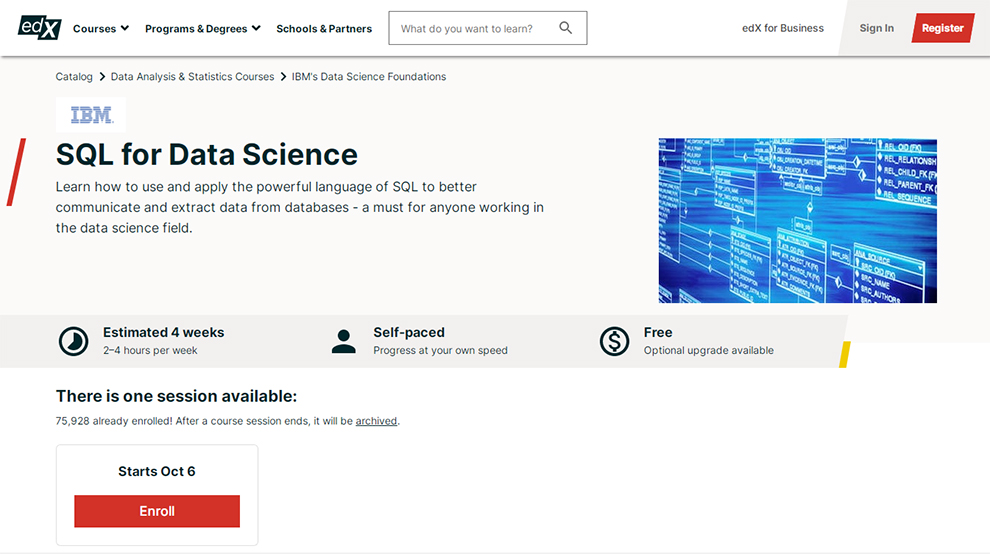
To learn SQL for data science and effectively read through the data to draw insights from the database is essential for anyone working in data research.
To progress as a data scientist or machine learning professional, you must have a working knowledge of how to play around with the database, and for that, you have to learn SQL for data science.
The goal of this course is to get you started with SQL access and introduce you to relational database to acquire fundamental SQL language expertise.
This course gives you hands-on training working through real-world datasets. You will also learn SQL for data science and Python to access databases from Jupyter notebooks.
| Enrollments | 75900+ |
| Duration | 14 – 16 hours |
| Level | Introductory |
| Certificate Provided | Yes (If choosing to upgrade with a fee) |
| Course Material Provided | Yes |
| Live Classes/Recorded Lessons | Recorded lessons |
| Course Type | Free (with an option to upgrade to a paid course) |
| Instructor | Rav Ahuja |
| Scope for Improvement (Cons) | Certificate not included in the free track. |
Topics Covered
- Application of SQL language
- Extract data from databases
- Creating a cloud database
- Use of Python in analyzing data
Learning Outcome after pursuing
- SQL language’s fundamentals intro to SQL for data science
- Know how to create a Cloud Database
- Using Python to analyze data
- How to query data using string patterns and ranges
- Sorting and grouping data in result sets and by data type
Prerequisites
There is no requirement for one to be acquainted with an understanding of databases, SQL, Python, or programming. This course is meant for beginners who wish to deploy SQL in data science.
Is it the right course for you?
This course is for everyone working in the discipline of data science.
3. Databases and SQL for Data Science with Python by IBM – (Coursera)
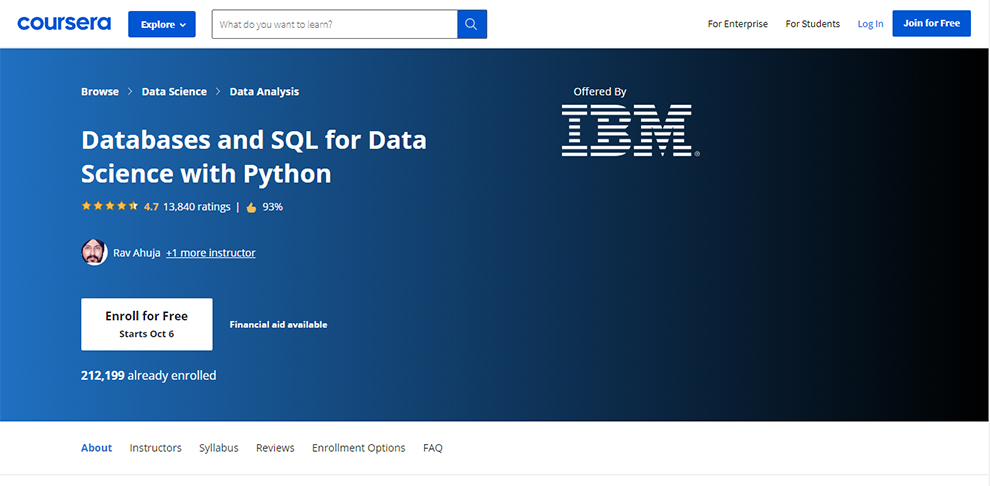
SQL (or Structured Query Language) is a strong language for connecting with and extracting data from databases. A working grasp of databases and SQL in data science is required if you wish to become a data scientist.
The goal of this course is to introduce you to relational database ideas and to help you understand and apply fundamental SQL knowledge. It is also intended to get you started with SQL access in a data science context.
| Rating | 4.7 based on 13,825 ratings |
| Duration | Approximately 19 hours |
| Level | Beginner level |
| Certificate Provided | Yes (If choosing the paid course) |
| Course Material Provided | Yes |
| Live Classes/Recorded Lessons | Recorded lessons |
| Course Type | Free (with an option to upgrade to paid course) |
| Instructor | Rav Ahuja and Hima Vasudevan |
| Scope for Improvement (Cons) |
The course is not updated for a long time and the IBM cloud function does not work properly at all. |
Topics covered
1. Getting Started with SQL
Firstly, you will be taught what a database is and how to create a database instance on the cloud. In addition, you will work on a live database with SQL.
2. Introduction to Relational Databases and Tables
This session will introduce you to the essential principles behind databases, tables, and the interactions between them. You will then learn SQL basics for data science specialization and employ it in data tables.
3. Intermediate SQL
This module will teach you to sort and categorize data. It will also teach you to use string patterns and ranges to look for data from multiple tables as well.
4. Accessing Databases using Python
This part brings you closer to the basics of Python and using it to connect to databases. You’ll create tables, import data, query data with SQL, and analyze data with Python in a Jupyter Notebook.
5. Course Assignment
6. Bonus Module: Advanced SQL for Data Engineering (Honors)
In this module, you’ll learn SQL for data science including advanced SQL techniques like views, transactions, stored procedures, and joins to create more complex queries.
Learning Outcome
- Create and use a cloud database instance.
- CREATE, DROP, SELECT, INSERT, UPDATE, and DELETE is examples of basic SQL statements.
- Filter, sort, and group results, as well as use built-in functions and access numerous tables.
- Python may be used to access databases from Jupyter and interact with real-world datasets.
Prerequisites
It is not necessary to have any prior experience in databases, SQL, Python, or programming.
Is it the right course for you?
This course is the best SQL course for data science for everyone who wants to become a data scientist by gaining knowledge of databases and learning SQL for data science.
4. Master SQL for Data Science – (Udemy)
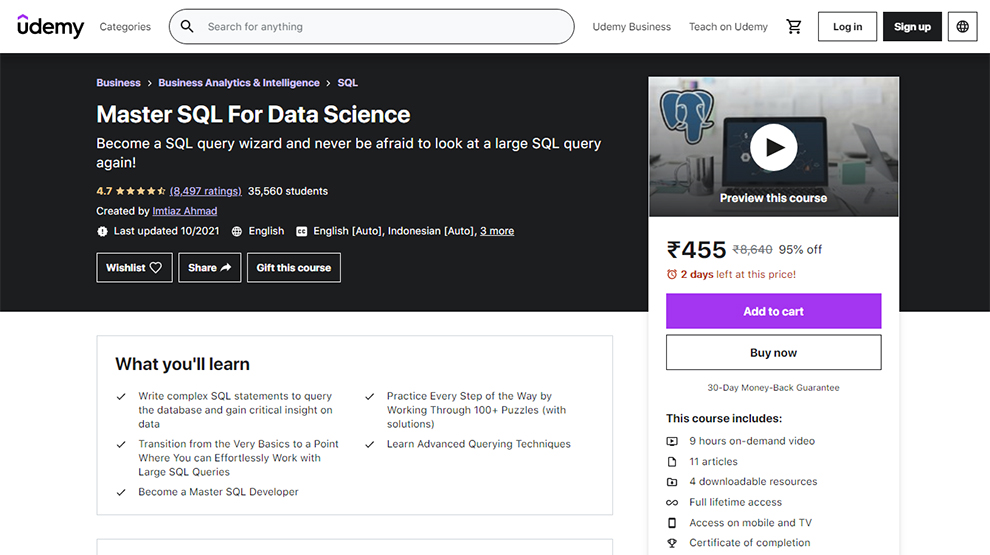
This course will teach you how to write SQL queries like a pro. You’ll learn how to extract crucial information from data stored in a database. Over 100 puzzles with in-depth solutions are strewn throughout the course, giving you lots of opportunities to practice.
We guarantee that once you’ve completed the course and all of the assignments, you’ll never be afraid to look at a lengthy SQL query again.
This best SQL course for data science follows the no-student-left-behind principle, which means the course starts from the very beginning. There are no prerequisites for taking this course.
It progresses to more sophisticated subjects as it explores advanced querying techniques like as subqueries, aggregations, joins, rollups and cubes, window functions, data transposing and sorting, and conditional expressions in new directions.
| Rating | 4.6 based on 8480+ ratings |
| Duration | 9 hours 24 minutes |
| Level | Beginner level |
| Refund Policy | 30 days money-back policy |
| Certificate Provided | Yes |
| Course Material Provided | Yes |
| Live Classes/Recorded Lessons | Recorded lessons |
| Course Type | Paid |
| Instructor | Imtiaz Ahmad |
| Scope for Improvement (Cons) | The instructor should actively resolve the queries of the learners. |
Topics covered
- Course Overview
- Database basics
- SQL Query basics
- Using Functions
- Grouping Data and Computing Aggregates
- Using Subqueries
- Using the CASE Clause in interesting ways
- Advanced Query Techniques using Correlated Subqueries
- Working with Multiple Tables
- Window Functions for Analytics
- Difficult Query Challenges
Learning Outcome
- To query the database and acquire vital insight into data, write complicated SQL statements.
- Working Through 100+ Puzzles will help you practice every step of the way (with solutions)
- Transition from the fundamentals to being able to work with large SQL queries with ease.
- Improve Your Querying Skills by Learning Advanced Querying Techniques
- Become a SQL Developer Master
Prerequisites
There are no prerequisites for this training.
Is it the right course for you?
- Is anyone interested in becoming a data analyst or data scientist?
- Anyone who wants to learn how to write queries and use SQL in data science
5. SQL for Data Science – (Great Learning)
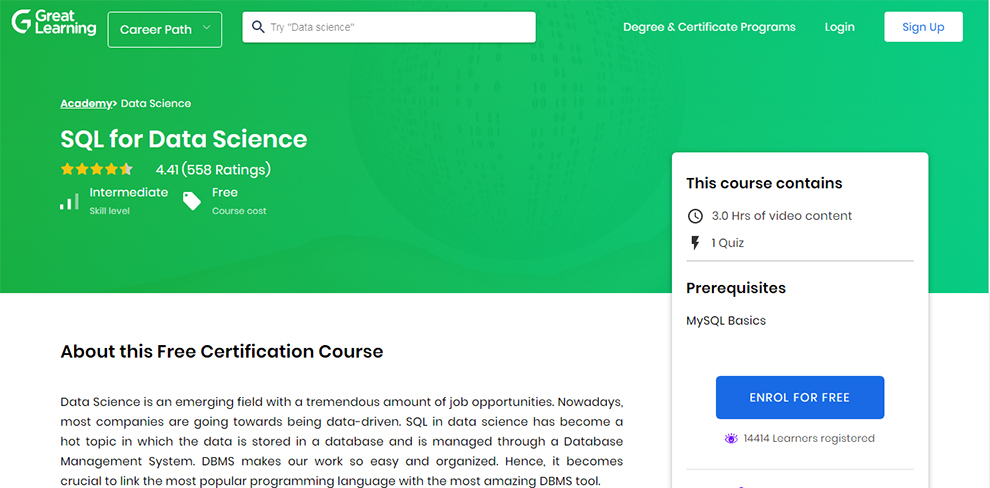
Today, it’s critical to connect the most popular programming language with the most impressive database management system.
SQL is one of the most significant languages when it comes to the subject of Data Science to master. As a result, Great Learning has put together this informative SQL for data science certification course to help you master the subject.
| Rating | 4.42 based on 550+ ratings |
| Duration | 2.5 hours |
| Level | Intermediate |
| Learners | 14300+ |
| Certificate Provided | Yes, SQL for data science certification provided |
| Course Material Provided | Yes |
| Live Classes/Recorded Lessons | Recorded lessons |
| Course Type | Free |
| Course Provider | Great Learning Academy |
| Scope for Improvement (Cons) | It is a short course for intermediate knowledge. |
Topics Covered
- Course Overview
- Intro to Clauses
- Group by Statement
- Demo for Group By Statement
- Having Clause Statement
- Demo for having Clause
- Alias in SQL
- Joins in SQL
- Types of Joins in SQL
- INNER Join
- LEFT Join
- RIGHT Join
- FULL Join
- SELF Join
- Intro to Subquery
- Problem Statement
- What is a Subquery?
- How Subquery execute?
- Types of Subquery
- Demo for Subqueries
- Introduction to SQL for data science with Python
- History of Python
- Why should you learn Python
- Why is Python so popular
- Installing Python
- MySQL with Python Demo
Learning Outcome
- Group By
- Having Clause
- Joins
- Subquery
- SQL with Python
Prerequisites
MySQL Basics
Is it the right course for you?
This course is the ideal choice for anyone who wants to learn SQL in Data science.
6. SQL for Data Analysis – (Udacity)
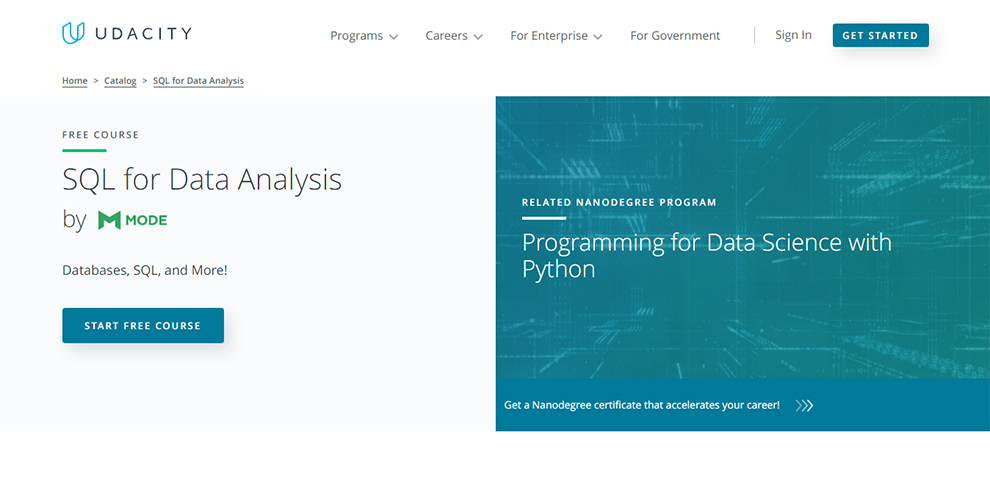
For data analysts and data scientists, SQL is the most often used data analysis tool. The majority of the world’s data is housed in a database and knowing SQL will allow you to easily access and analyze it.
SQL is a useful tool for a variety of professions in a variety of industries—digital marketers, engineers, product managers, and others all utilize it daily.
The capacity to do essential data work on your own with SQL adds to the value you’ll bring to any company.
This SQL for data science certification course will teach you how to extract and analyze data from databases using Structured Query Language (SQL). To begin, you’ll learn SQL basics for data science specialization and get comfortable extracting information from data, joining tables, and conducting aggregations.
Then you’ll learn how to use subqueries, temp tables, and window functions to perform more advanced analysis and manipulations. You’ll be able to design effective SQL queries to handle a variety of data analysis tasks by the end of the course.
| Rating | 4.42 based on 554 ratings |
| Duration | Approximately 4 weeks |
| Level | Beginner level |
| Certificate Provided | No |
| Course Material Provided | Yes |
| Live Classes/Recorded Lessons | Recorded lessons |
| Course Type | Free |
| Course Provider | Derek Steer |
Topics Covered
1. SQL Basics
- Learn SQL basics for data science specialization
- Learn how to construct basic SQL statements such as SELECT, FROM, and WHERE.
- Understand how to use logical operators in SQL.
2. SQL Joins
- Learn how to use INNER JOINS to join data from several tables.
- LEFT JOINs are used to merge data from various tables.
3. SQL Aggregations
- Learn how to build typical SQL aggregations such as COUNT, SUM, MIN, and MAX.
- Learn how to build CASE and DATE functions, as well as how to deal with NULL values.
4. Subqueries and Temp Tables
- Learn how to build subqueries to perform many queries at the same time.
- Learn how to use temp tables to reach a table with multiple queries.
5. SQL Data cleaning
- Discover how to use SQL to clean data.
6. Window Functions
- Learn how to employ window functions to complete additional analysis tasks.
Learning Outcome
You’ll be able to design effective SQL queries to handle a variety of data analysis tasks by the end of the course.
Prerequisites
Learners should have a basic understanding of how to work with data in spreadsheets.
Is it the right course for you?
This is the right course for anyone interested in learning Python, SQL in Data Science, the Terminal, and Git.
Related: Best SQL Books
Conclusion
So, these were the six best SQL courses for Data Science. We suggest you go through the annexed links to go through further details of the course. Pick one that fits your experience level and requirements.

